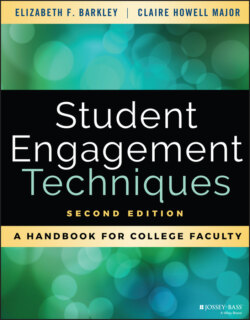Читать книгу Student Engagement Techniques - Elizabeth F. Barkley - Страница 47
Memory
ОглавлениеOnce students learn something, we want them to remember it. There are currently several different models describing memory, but a basic and generally accepted classification divides memory into two main types: short term and long term. Short-term memory gives continuity from one moment to the next and allows us to carry out hundreds of tasks each day by holding the data we are dealing with at the moment, but then letting it go so that our brain can turn its attention to other things. Short-term memory is where the brain works with new information until it decides if and where to store it more permanently. While short-term memory is supported by transient neuronal networks and functions as temporary storage, long-term memory is retained for greater lengths of time—days, decades, even an entire lifetime. It is structurally different from short-term memory in that it is maintained by permanent cellular changes that have been created by neuronal connections distributed throughout the brain. We want students to remember important new learning in the long term, so how do short-term memories become long-term memories? Research suggests that there is a special window in time during which this transition occurs: the time needed for neurons to synthesize the necessary proteins for “long-term potentiation” (LTP). An initial stimulation triggers communication across the synapse between two neurons; further stimulation causes the cells to produce key proteins that bind to the synapse, cementing the memory in place. If the memory is to last for more than a few hours, these proteins must bind to specific synapses and actually change the cellular structure.
The criteria by which short-term memory determines whether or not information should be stored for the long term is complex. Information tied to survival or information that has a strong emotional component has a high likelihood of being permanently stored. In classrooms, where these two elements are generally minimal or absent, other factors come into play. One important factor is whether or not the information “makes sense”—does it fit with what the learner already knows about the way the world works? When students say that they don't understand, it means that they cannot make sense of what they are learning, and hence probably won't remember it. The other important factor is whether or not the information “has meaning”—is it relevant, is there some reason the learner has for remembering it?
We remember some information just because it made sense, even though it isn't particularly meaningful to us (this is the kind of data people may recall when they are doing crossword puzzles or playing games such as Trivial Pursuit). We also remember information that didn't make sense to us just because it had meaning (it was important for us to memorize it in order to pass a test). Of the two criterion, meaning is more significant. For example, telling a student that they need x number of units in their academic major for a degree at your institution, but y number of units if they attended a different institution in another state “makes sense,” but the student will have a higher likelihood of remembering the number of units at her own institution because it is more meaningful and relevant to her educational plans. Thus, when new learning is readily comprehensible (it makes sense) and can be connected to past experiences (it has meaning), retention is dramatically improved (Sousa, 2006, pp. 49–51).
